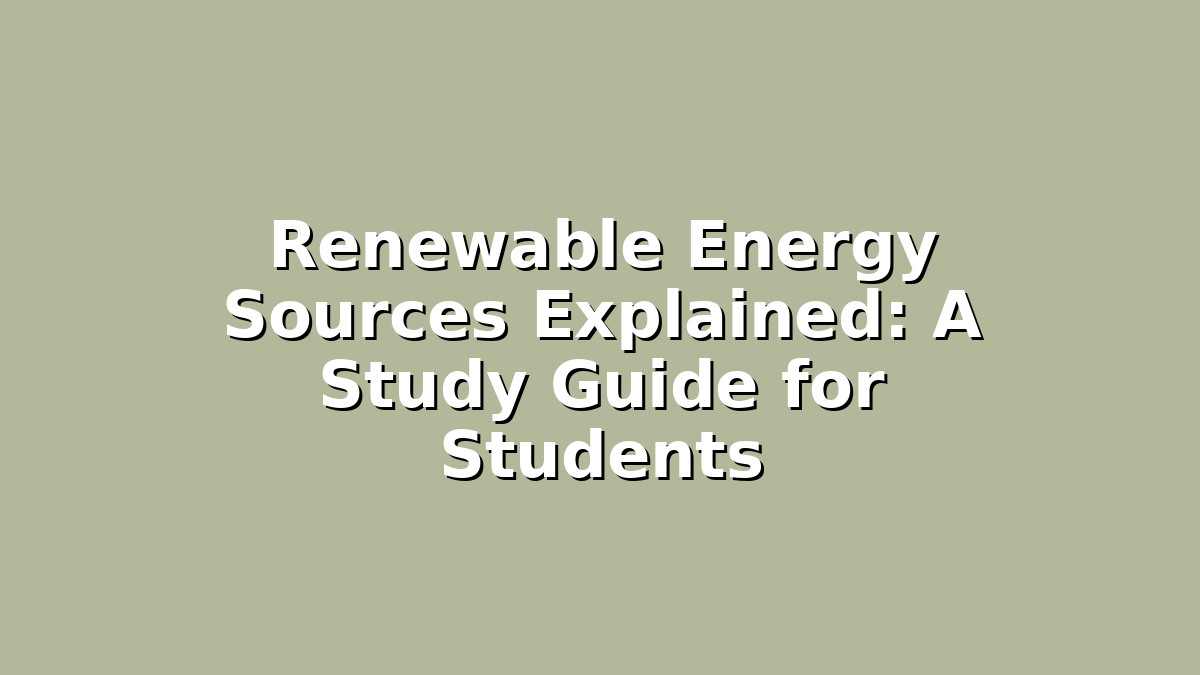As students preparing for exams, especially in science or environmental studies, understanding renewable energy sources is essential. Not only is this topic frequently featured in curricula and exams, but it also relates to one of the most important global challenges of our time: sustainable energy and climate change. This comprehensive guide will explain the main renewable energy sources, their benefits, and some effective study tips to help you master the topic with confidence.
Introduction: Why Study Renewable Energy?
Renewable energy refers to energy derived from natural resources that are replenished constantly. Unlike fossil fuels, which are finite and contribute to pollution, renewable sources offer cleaner, sustainable alternatives. Knowing about renewable energy empowers you to engage in discussions about the environment, future technologies, and global policies.
For students, renewable energy is often a complex subject involving science, technology, and environmental impacts. The good news is, with clear explanations and smart study habits, you can grasp these concepts and excel in your exams.
—
1. Understanding the Main Types of Renewable Energy
The first step to mastering this topic is to get familiar with the main types of renewable energy sources. Each type harnesses a different natural process, and understanding these differences will help you remember their characteristics and uses.
Solar Energy
Solar energy uses sunlight to generate electricity or heat. Solar panels made of photovoltaic cells convert sunlight directly into electricity. This energy source is abundant, especially in sunny regions, and is becoming more affordable thanks to technological advances. For exams, remember key terms like “photovoltaic cells,” “solar thermal,” and “solar farms.”
Study Tip: Create flashcards with definitions and examples of solar energy terms. Visual aids like diagrams of how solar panels work can also make the concept clearer and easier to recall.
Wind Energy
Wind energy uses the kinetic energy of moving air to generate electricity. Wind turbines are tall structures with blades that spin when the wind blows, turning a generator to produce power. Wind farms can be located on land or offshore. This source is renewable and produces no emissions, but it depends on wind availability.
Study Tip: Watch videos or animations that show wind turbines in action. Associating the process with real-world images can help solidify your understanding and make your answers more descriptive.
Hydropower
Hydropower generates electricity by using flowing water, typically from rivers or dams. The movement of water spins turbines connected to generators. It is one of the oldest renewable energy sources and plays a significant role in many countries’ energy mix.
Study Tip: When revising, try drawing a simple flow diagram of a hydropower system: water source → turbine → generator → electricity. This visualization helps you organize information logically and makes it easier to write structured answers.
—
2. Benefits and Challenges of Renewable Energy
Understanding renewable energy isn’t just about knowing what they are but also appreciating their advantages and limitations. This holistic knowledge will impress examiners and deepen your comprehension.
Benefits
– Environmentally Friendly: Renewable energy reduces greenhouse gas emissions, which helps combat climate change.
– Sustainable: These sources will not run out, unlike coal or oil.
– Economic Growth: They create jobs and foster technological innovation.
– Energy Security: Countries can reduce their dependence on imported fuels.
Challenges
– Intermittency: Solar and wind energy depend on weather and time of day.
– Initial Costs: Setting up renewable infrastructure can be expensive.
– Environmental Impact: Some hydropower projects affect aquatic ecosystems, and wind turbines may impact bird migration.
Study Tip: Make a two-column table listing benefits and challenges. This simple yet effective method helps you compare and contrast quickly during revision. When answering exam questions, citing both sides shows balanced analysis.
—
3. Effective Study Strategies for Renewable Energy Topics
Mastering renewable energy requires not just memorizing facts but understanding concepts and applying them. Here are some study strategies tailored to help you succeed.
Use Mind Maps
Create a mind map with “Renewable Energy” at the center and branches for types, benefits, challenges, and real-life examples. This helps organize information visually and improves memory retention.
Practice Past Papers
Find previous exam questions related to renewable energy and practice writing full answers. This approach familiarizes you with question formats and builds your confidence in articulating ideas clearly.
Group Study Sessions
Discussing topics with classmates can expose you to different perspectives and clarify doubts. Try explaining renewable energy concepts to others—it’s a powerful way to reinforce your own understanding.
Incorporate Real-World Examples
Linking theory to current news or case studies about renewable energy projects makes learning more relevant and engaging. For example, research the latest solar energy initiatives in your country and mention them when revising.
Make Use of Educational Videos and Podcasts
Multimedia resources can break down complex processes into easy-to-understand segments. Find reputable channels or podcasts focused on renewable energy to supplement your reading.
—
Conclusion: Stay Curious and Keep Learning
Renewable energy is a dynamic and vital subject for students aiming to excel in their exams and beyond. By understanding the types of renewable energy, their pros and cons, and adopting effective study techniques, you can build strong knowledge with confidence.
Remember, the key is consistent effort and curiosity. Stay motivated by thinking about how mastering this topic connects you to bigger global issues like climate change and sustainable development. With the right mindset and study habits, renewable energy can become one of your favorite subjects to learn.
Good luck, and keep pushing forward—you’ve got this!
—

Responses